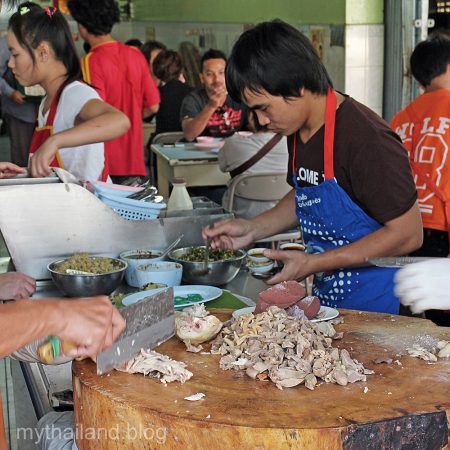
Real Thai Food-A Tourists Dilemma
My favorite kao mun gai (fat rice & chicken) eatery is in Chiang Mai. (See my rare video below!) It’s been dishing up kao mun gai, satay and miscellaneous poultry guts for over 60 years-far longer than Chiang Mai has been a tourist mecca.
This restaurant is well known to all the local Thais- always hustling and bustling. But rarely do White people eat here, just Thais. And that’s the bone I want to pick with you farangs (White people).
From inside, you can watch the farang tourists stroll by on the sidewalk out front. (Chiang Mai is swamped with farang tourists.) Most farangs are unaware that they’re even walking past an eatery that the locals consider one of the best fat rice & chicken places in all Chiang Mai. A few farangs stop briefly to look inside, but quickly continue walking.
The white tourist sees only Thai faces eating there; plucked chickens hanging upside down where the food is prepared; chalkboard menus only in Thai; and an eatery looking dingy and “dirty” to their white eyes. The farang tourists (or at least those who even noticed the restaurant) quickly conclude that this eatery isn’t for them. Thais only.
A cultural divide has cracked open.
Kao Mun Gai Basics (ข้าวมันไก่)

Fat Rice & chicken (kao mun gai) is one of the most traditional meals throughout The Kingdom. Tourists naturally think Pad Thai is the national dish; but no, kao mun gai is far more common.
Kao mun gai is exactly what it says-rice made with chicken fat served with boiled chicken parts and chicken broth. Everything served on separate plates and bowls. But what gives kao mun gai its character is the sauce-mung beans, mild red & green chiles, and ginger. The sauce is often what distinguishes the good kao mun gai from the ordinary.
Kao mun gai is often called Hainanese Chicken and is ubiquitous all over Indochina.
Culture Klash-West Meets East

This cultural divide that stops tourists from crossing into this Thai restaurant quickly becomes a yawning chasm between farang culture and Thai culture. And if you don’t have Thai friends or family, there is no easy bridge to cross into Thai culinary culture.
I find this behavior both understandable, yet quizzical. If you ask a white tourist if they’d like to eat great Thai food, they’d say “of course” enthusiastically. If you ask them if they’d enjoy dining in an old-style Thai manner, they’d say “absolutely”. If you ask them if they’d like to pay $1 for lunch, they’d say “great”!
But tourists don’t eat at this kao mun gai place in Chiang Mai even though they’ve traveled half-way round the world to get here AND Thai food is a top priority for their vacation!
Tourists want a place that has English menus and Westernized Thai food. (Hold the fish sauce and shrimp paste!) A place that fits with their notion of restaurant cleanliness. A place where the mung bean sauce isn’t ladled out of a pink plastic bucket. A place where East meets West and the West wins.
And above all else, most tourists want to eat and hang out where other tourists eat and hang out. The herd mentality.
Here at my kao mun gai place, West just wasn’t interested in meeting East and East didn’t care.
Crossing the Culinary Chasm

So how is it that me, a White guy, not only eats here but craves its authentic kao mun gai especially when I’m far from Thailand?
Anyone who tells you they love Thai food the first, second or third time trying it, either isn’t telling you the truth or they’re eating highly Westernized Thai food. A White person just doesn’t grab a bottle of fish sauce and start guzzling it with gusto. Thai food in Thailand is a long cultural journey.
It took me years to cross the great Siamese cultural chasm. And of course, I have a Thai wife and family that dragged me kicking and screaming across. But farang tourists don’t have decades to acclimate themselves to Thai life, nor a Thai family. So what’s the best way to deal with this cultural chasm?
Simply realizing it exists is the first step. Bon appetit!
A Little Advice

Here’s a few tips for eating at traditional Thai eateries in Thailand that I humbly offer up.
1. When you see a Thai restaurant where lots of Thai people are eating, you’ve probably found a Thai restaurant that serves good Thai food.
2. Go take a look at the Thai food. See what’s cooking. Literally sniff around-Thai people do that all the time. Traditional Thai restaurants often prepare the food at the front of the restaurant in an open area where you can see the food being prepared and cooked.
3. This is a biggy: If you think you might get sick from eating the food, DO NOT EAT IT! Trying new foods and being culturally adventurous does not include seeing how much bacteria your body takes to get violently ill! (Tip: Eat foods that are prepared hot [I mean the food temperature.] The odds of getting sick from boiled or fried foods is astronomically lower than getting sick from raw foods.) I can honestly tell you that after 20 years, I’ve never gotten sick from eating at a food stand or traditional Thai restaurant.
4. If the food, preparation and cooking are to your liking, then get some. Communicate with your hands or whatever gets the job done. Point a lot and nod your head in agreement. Smile. Throw out a few Thai words that you know. You don’t have to speak or read Thai to order your food.


Leave a Reply